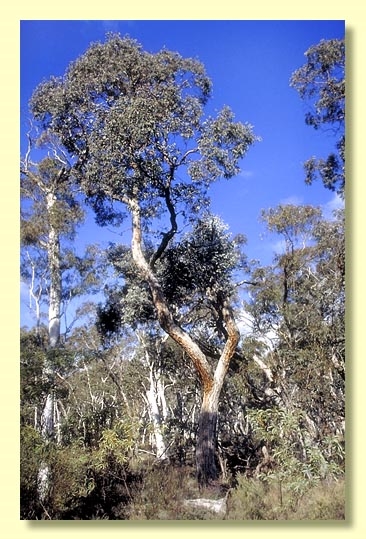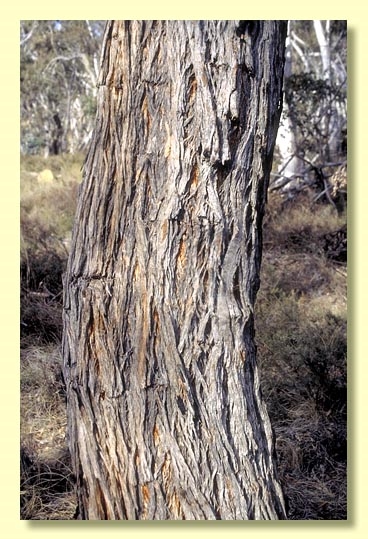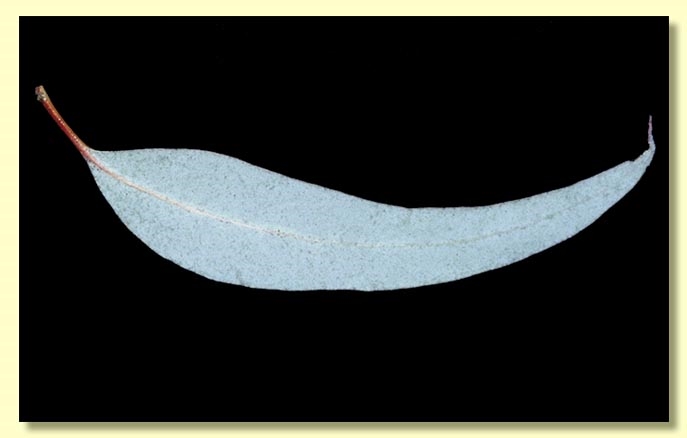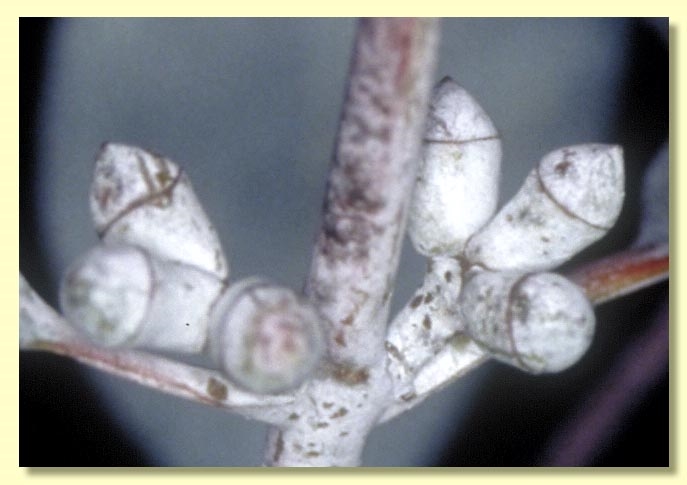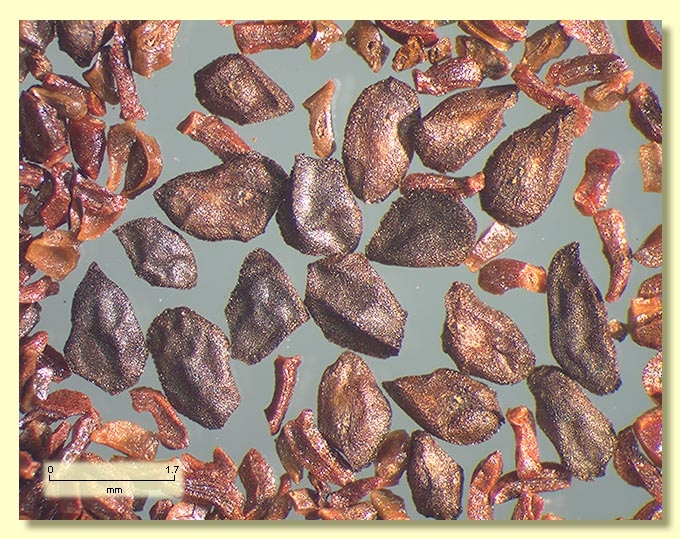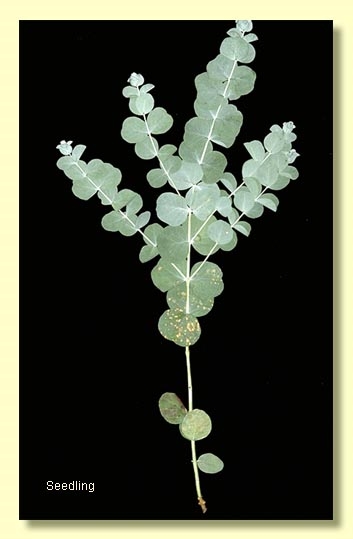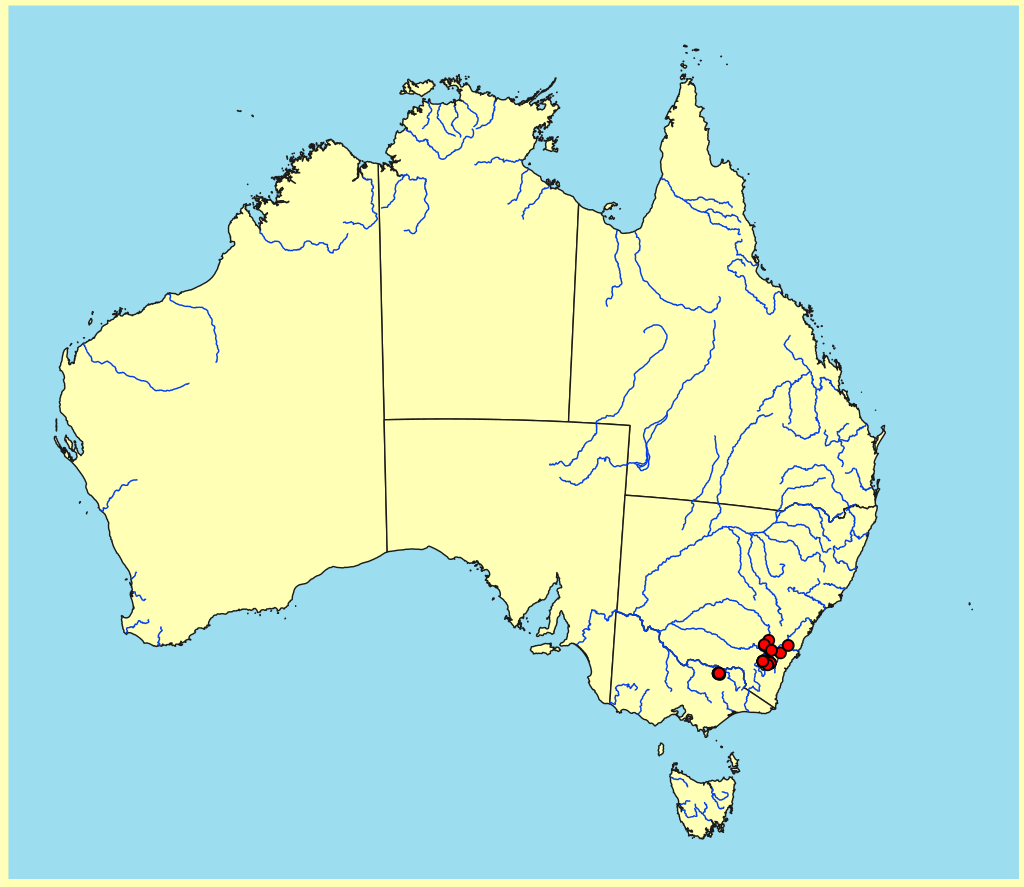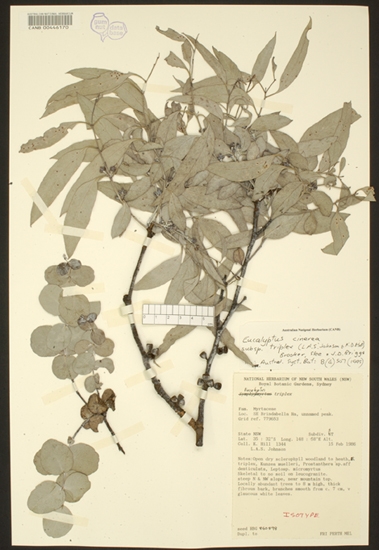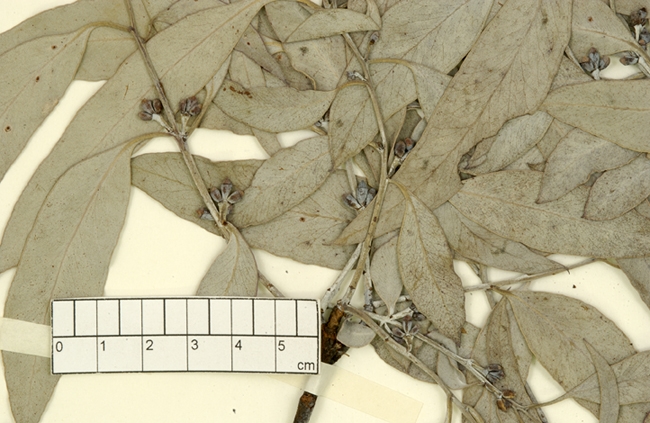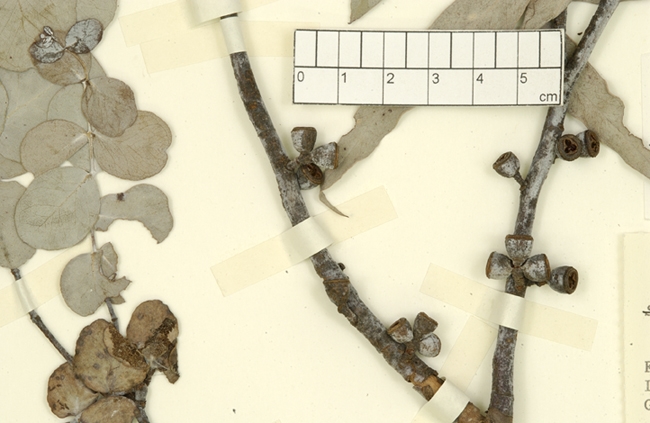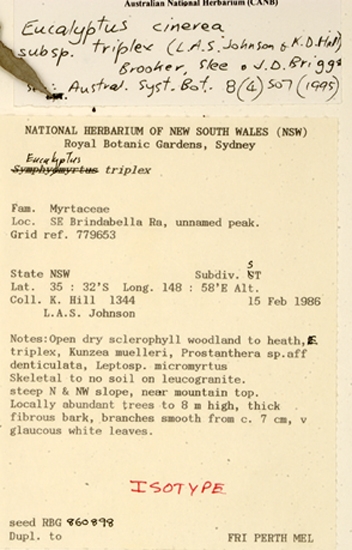Eucalyptus | Symphyomyrtus | Maidenaria | Euryotae | Argyrophyllae
Euclid - Online edition
Eucalyptus cinerea subsp. triplex
Eucalyptus cinerea subsp. triplex (L.A.S.Johnson & K.D.Hill) Brooker, Slee & J.D.Briggs, Aust. Syst. Bot. 8: 507 (1995).
E. triplex L.A.S.Johnson & K.D.Hill, Telopea 4: 61 (1990). T: Australian Capital Territory: SE Brindabella Range, on unnamed peak, 15 Feb. 1986, K.D.Hill 1344 & L.A.S.Johnson; holo: NSW; iso: CANB.
Tree to 10 m tall. Forming a lignotuber.
Bark rough to small branches, thick, fibrous, furrowed longitudinally, grey over red-brown.
Juvenile growth (coppice or field seedlings to 50 cm): stems round, glaucous; juvenile leaves sessile, opposite for many pairs, orbicular to broadly ovate, to 8 cm long, 4.5 cm wide, glaucous.
Crown of mature tree composed of mixed juvenile, intermediate and adult leaves or predominantly intermediate and adult leaves. Intermediate leaves opposite with petioles 0.4–1.5 cm, ovate to lanceolate, 4.8–9 cm long, 2–4.5 cm wide.
Adult leaves alternate, petiole 0–2 cm long; blade lanceolate to slightly falcate, 3.5–12 cm long, 1.2–3 cm wide, base rounded or tapering to petiole, concolorous, dull, grey-green, usually glaucous, side-veins greater than 45° to midrib, reticulation dense, intramarginal vein close to margin or remote from it, with few to numerous island oil glands.
Inflorescence axillary unbranched; peduncle to 0.2–0.9 cm long, buds 3 per umbel, sessile or shortly pedicellate (pedicels to 0.2 cm long). Mature buds diamond-shaped, to 0.6–0.7 cm long, 0.3–0.4 cm wide, scar present, operculum conical, stamens inflexed, anthers cuneate, versatile, dorsifixed, dehiscing by longitudinal slits, locules 3 or 4, the placentae each with ovules in 4 vertical rows. Flowers white.
Fruit sessile or with pedicel to 0.2 cm, obconical to campanulate, 0.4–0.6 cm long, 0.4–0.8 cm wide, disc raised-annular, valves 3 or 4, rim level or slightly exserted.
Seeds grey-brown to blackish, ovoid or flattened-ovoid, minutely pitted, hilum ventral.
Cultivated seedlings (measured at ca node 10): cotyledons bilobed; stems rounded in cross-section, glaucous; leaves sessile, opposite for many pairs, orbicular to cordate, 2–4.5 cm long, 2.2–6 cm wide, base usually amplexicaul, rarely rounded, margin entire or subcrenulate, apex rounded to emarginate, glaucous or blue-grey.
Flowering has been recorded in February.
Eucalyptus cinerea is a small tree species sporadically distributed on the Central and Southern Tablelands and adjacent Western Slopes of New South Wales, south to Beechworth in north-eastern Victoria. It is notable for the thick rough bark and the mature crown of largely grey or glaucous juvenile to intermediate leaves, and sometimes adult leaves.
It consists of two subspecies:
E. cinerea subsp. cinerea
Has a high proportion of opposite, sessile, orbicular to broadly ovate juvenile leaves in the mature crown. In New South Wales it is common around Abercrombie River, Wattle Flat, Frogmore, Marulan, Bungonia, Gunning, Dalton, Rye Park north of Yass, south of Tumut on Wereboldera Hill, north-east of Nerriga at Touga. In Victoria it is known from near Beechworth.
E. cinerea subsp. triplex
Has a high proportion of opposite, petiolate, ovate intermediate leaves and alternate, petiolate, lanceolate adult leaves in the crown, but sessile leaves also may be present. Only known from granitic mountains south-west of Canberra, Australian Capital Territory, plus a small population north-west of Captains Flat, another in Tinderry Nature Reserve in nearby New South Wales. Occasional trees matching subsp. triplex occur in populations where other trees match subsp. cinerea in regards "adultness" of the crown, e.g. in the area between Yass, Dalton and Murrumbateman, Bungonia and Marulan in New South Wales and in Victoria in the Beechworth area.
Eucalyptus cinerea belongs in Eucalyptus subgenus Symphyomyrtus section Maidenaria, a large group of species more or less restricted to south-eastern Australia, characterised by bilobed cotyledons, simple axillary inflorescences, buds with two opercula, stamens with versatile anthers and flattened seeds with a ventral hilum. Within this section, E. cinerea belongs in series Argyrophyllae having longitudinally furrowed fibrous rough bark throughout, orbicular or ovate juvenile leaves opposite for many nodes and small diamond-shaped buds in threes. Of the other species in the series E. alligatrix has a greener, more adult-leaved crown, E. conspicua has buds in sevens, E. cephalocarpa and E. nova-anglica have completely adult crown and buds in sevens. These 5 species form series Argyrophyllae.
The related species Eucalyptus pulverulenta has a similar juvenile crown to E. cinerea subsp. cinerea but differs in having mallee habit, smooth bark shedding in ribbons, a sparse crown of stiffer leaves and larger buds with creamy-yellow stamens and larger fruit.
In 2018 Rule & Walsh described as new E. cinerea subsp. victoriensis applied to the trees in the Beechworth area in north-eastern Victoria. They state that this population differs from both other subspecies of E. cinerea by: inner crown leaves juvenile and intermediate, outer crown leaves adult, more erect tree habit and slightly smaller buds and fruit. Recognized in EUCLID as being a population variable in adult crown leaf characteristics but see comment above under subsp. triplex, and note under Nomenclature. The authors of EUCLID regard the distinction between subsp. triplex and subsp. victoriensis as slight and may depend on regenerative state of the crown or even crown health. The Beechworth trees of E. cinerea regularly flower in the axils of crown leaves regardless of developmental stage (juvenile, intermediate or adult leaves).
Eucalyptus cinerea is one of the most popular of the temperate eucalypts in cultivation, especially in colder areas. It is commonly grown in southern Australia, New Zealand and many other countries.
Eucalyptus cinerea has become naturalised in Canberra, Australian Capital Territory and no doubt in other places. It is weedy in Hawai'i.
subsp. triplex: Latin triplex triple, three-fold, referring to the 3-flowered inflorescences.

